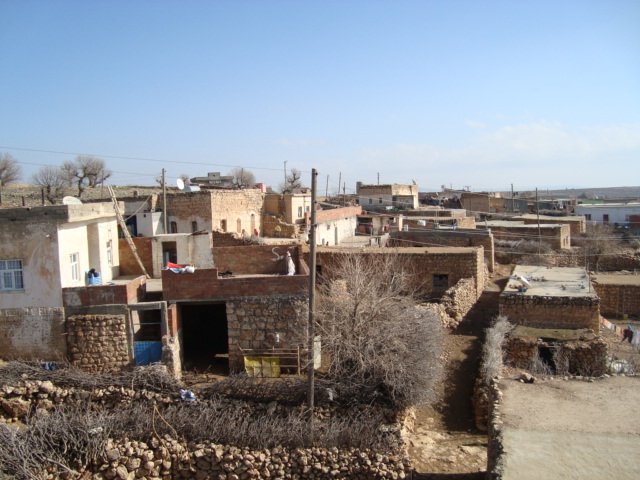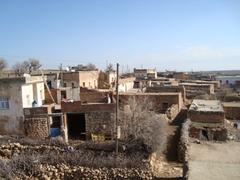
Midyat Historical Sites Visiting Guide: Tickets, Hours, and Essential Travel Tips
Date: 14/06/2025
Introduction to Midyat and Its Historical Significance
Midyat, a jewel in Mardin Province of southeastern Turkey, stands as a living museum of human civilization. With a history stretching over 3,000 years, it was once called “Matiate” and has witnessed the ebb and flow of empires including the Mitannians, Assyrians, Romans, Byzantines, and Ottomans. This deep historical layering has granted Midyat a unique multicultural identity, especially as a heartland of Syriac Christianity—home to more than 100 historic churches and 70 monasteries, such as the legendary Mor Gabriel Monastery, founded in 397 AD (Wikipedia; Ancient Origins; Wow Cappadocia).
Beneath the picturesque limestone facades lies the Matiate Underground City, recently uncovered and revealing a sprawling network of tunnels and chambers dating back nearly 1,900 years. This subterranean marvel protected early Christians fleeing persecution and has become one of the region’s most fascinating archaeological discoveries (Daily Sabah; VOA News).
Midyat’s enduring spirit is not only reflected in its ancient stones but also in its living traditions. Visitors encounter a cultural mosaic where Assyrian, Kurdish, Arab, Turkish, and other communities sustain languages, crafts, and culinary customs that span centuries. This guide provides essential details on visiting hours, ticketing, accessibility, and local highlights, ensuring you make the most of your journey through Midyat’s extraordinary past and vibrant present.
Ancient Roots & Religious Heritage
Early Settlement and Assyrian Legacy
Midyat’s earliest records date to Assyrian tablets from the 9th century BCE, referencing “Matiate.” Assyrian rulers such as Ashurnasirpal II and Shalmaneser III passed through the region, and over centuries, successive empires left their mark (Wikipedia; Ancient Origins).
Rise of Syriac Christianity and Tur Abdin
By late antiquity, Midyat became a major Syriac Christian center and the unofficial capital of Tur Abdin. It was home to a predominantly Syriac Orthodox population with Orthodox, Catholic, and Protestant communities, and modern Aramaic (Surayt) was widely spoken (Wikipedia). The area is dotted with historic monasteries and churches, notably Mor Gabriel Monastery (Cities and Attractions).
Demographic Changes in the Modern Era
Before World War I, Midyat was unique for its Assyrian majority within the Ottoman Empire, though religiously diverse (Wikipedia). The events of 1915 and subsequent migrations drastically reduced the Christian population. Today, only a few hundred Assyrian Christians remain, joined by Syriac refugees, but the city’s Christian architectural heritage is still visible.
Recent Archaeological Discoveries: Matiate Underground City
Discovery and Structure
Midyat’s underground city was discovered in the early 2020s during conservation works. Archaeologists uncovered a vast network of rooms, tunnels, wells, and worship spaces beneath the town, now known as Matiate (Daily Sabah). Only about 3% of the site has been excavated, suggesting immense scale, with horizontal tunnels rather than vertical shafts as seen in Cappadocia (Ancient Origins; VOA News).
Historical Context and Legacy
Matiate likely began as a Christian refuge during Roman persecution, evolving to shelter up to 70,000 people at its height. The city features catacombs, storage spaces, and ritual carvings, with evidence of continuous use by various religious and ethnic groups (Daily Sabah; VOA News).
Artifacts—including amphorae, bronzes, and pottery—are now displayed at the Mardin Museum. The city’s enduring tradition of wine production links ancient and modern communities.
Visiting Hours, Tickets, and Accessibility
- Visiting Hours: Typically 9:00 AM–6:00 PM daily (may vary; check with the municipality).
- Tickets: About 50 Turkish Lira for adults; discounts for students/seniors.
- Accessibility: Some uneven and narrow areas; not all sites are suitable for visitors with mobility impairments.
Guided tours are available via the Midyat Municipality and local operators. Always confirm schedules ahead of your visit.
Multicultural Heritage & Living Traditions
Religious and Cultural Diversity
Midyat’s harmonious population includes Syriac Orthodox Christians, Assyrians, Kurds, Arabs, Turks, Chaldeans, Protestants, and Yazidis, with a range of languages spoken (moganddogtravels.com). Over nine churches, two monasteries, and several mosques highlight this diversity (happyfrogtravels.com).
Mor Gabriel Monastery, the world’s oldest surviving Syriac Orthodox monastery, is still active and conducts services in Aramaic (travelright.com). Other monuments like the Meryem Ana Monastery and Church of Mor Barsawmo further underscore the Christian heritage.
Architectural Heritage
Midyat’s signature yellow limestone houses, with ornate carvings and arched doorways, are masterpieces of local craftsmanship (cntravellerme.com). The old town’s labyrinthine streets, clock tower, and traditional mansions like the Midyat Konuk Evi offer an “open-air museum” atmosphere (moganddogtravels.com; happyfrogtravels.com).
Handicrafts and Artistry
Midyat is renowned for its telkari—exquisite silver filigree jewelry—along with stone carving, woodwork, and textiles (travelright.com; Citities.com). Workshops and bazaars offer both demonstrations and authentic souvenirs.
Culinary Heritage
The town’s cuisine blends Assyrian, Arab, Kurdish, and Turkish influences. Signature dishes include meat bread (etli ekmek), stuffed meatballs (içli köfte), lamb tandoori (kuzu tandır), and sweets like kliçe (Boutique Small Hotels). Breakfasts, often served in restored mansions, feature local cheeses, fresh tandoori bread, and zahter salad.
Festivals and Music
Midyat hosts vibrant religious festivals, music events, and oral storytelling sessions in Syriac and Kurdish. The sounds of saz and darbuka animate rooftops and courtyards, particularly during spring and autumn celebrations (chasingthedonkey.com).
Visitor Information: Hours, Tickets, and Practical Advice
Key Sites and Visiting Hours
- Mor Gabriel Monastery: 9:00 AM–5:00 PM (donations appreciated).
- Mor Hobil and Mor Abrohom Monastery: 8:00 AM–6:00 PM.
- Church of Yoldat Aloho (Meryem Ana), Anıtlı: Weekdays 9:00 AM–4:00 PM; closed on major religious holidays.
- Matiate Underground City: Guided tours, typically 9:00 AM–6:00 PM (subject to excavation schedule).
- Midyat Museum: 9:00 AM–6:00 PM; closed Mondays.
Tickets
- Religious Sites: Generally free; donations welcome.
- Underground City & Museums: 10–50 TRY; guided tours may cost extra.
Getting There & Around
- Location: 60 km east of Mardin city; 90 km from Mardin Airport.
- Transport: Accessible by car, public bus, or minibus; old town is best explored on foot.
Accommodation
- Options: Boutique hotels in historic mansions (e.g., Kasr-ı Nehroz, Shmayaa Hotel) and modern guesthouses (Boutique Small Hotels).
Best Time to Visit
- Seasons: Spring (April–June) and autumn (September–November) are ideal for mild weather and festivals (Trek Zone).
Accessibility
- Old Town: Cobblestone streets and stairs may pose challenges; some sites offer partial wheelchair access.
Safety, Etiquette & Shopping
- General Safety: Low crime; respect local customs.
- Dress Code: Modest attire recommended in religious sites.
- Shopping: Bargaining common; look for authentic telkari with certificates.
Communication
- Languages: Turkish, Kurdish, Arabic, Syriac; English limited outside tourist venues.
- Currency: Turkish Lira (TRY); cash preferred in markets, credit cards in hotels/restaurants.
Frequently Asked Questions (FAQs)
Q: What are Midyat’s visiting hours for main attractions?
A: Most sites open 9:00 AM–6:00 PM; monasteries may close earlier. Confirm ahead, especially for guided tours.
Q: Are tickets required?
A: Many sites are free; some require a small fee (10–50 TRY) or donation.
Q: Is Midyat accessible for travelers with disabilities?
A: Accessibility is limited in old town areas; inquire at sites beforehand.
Q: Are guided tours available?
A: Yes, through local agencies and hotels. Booking in advance is recommended.
Q: What is the best time to visit?
A: Spring and autumn for pleasant weather and fewer crowds.
Visuals and Interactive Content
Include optimized images of Mor Gabriel Monastery, Midyat’s stone houses, artisan workshops, and Matiate Underground City. Use descriptive alt tags such as “Mor Gabriel Monastery entrance in Midyat,” “Midyat visiting hours,” and “Mardin historical sites.”
Embed an interactive map highlighting key attractions and suggested walking routes.
Internal and External Links
- Midyat Travel Guide - Trip.com
- Boutique Small Hotels - What to Eat in Midyat
- Trek Zone - Midyat Overview
- Citities.com - Midyat Telkari Craft
Summary and Visitor Recommendations
Midyat stands as a crossroads where ancient history, religious faith, and living traditions meet. From its labyrinthine old town and intricately carved stone houses to the world’s oldest Syriac Orthodox monastery and the hidden Matiate Underground City, Midyat offers an immersive journey through time (Wow Cappadocia; Wikipedia). The town’s thriving handicraft scene, especially silver telkari, and its multicultural cuisine make every visit unique (Boutique Small Hotels; Citities.com).
For a rewarding experience, plan your visit with attention to opening hours, ticketing policies, and accessibility. Engage respectfully with local communities, support artisans, and participate in the region’s festivals. Download the Audiala app for real-time updates on tours and events, and share your discoveries on social media to inspire others. Begin your adventure and uncover the treasures of Midyat and its surroundings (Mog and Dog Travels; Travel Right).
Sources and Further Reading
- Wikipedia - Midyat
- Daily Sabah - Excavations Reveal Huge Underground City in Turkey’s Mardin
- VOA News - Ancient Secrets Unearthed in Vast Turkish Cave City
- Ancient Origins - Midyat Underground City
- Wow Cappadocia - Churches & Monasteries of Midyat
- Mog and Dog Travels - Things to Do in Mardin
- Boutique Small Hotels - What to Eat in Midyat
- Citities.com - Midyat Telkari Craft
- Travel Right - The 16 Best Things to Do in Mardin
